Civics: Government
Democracy ![]() Historical Documents
Historical Documents ![]() Three Branches
Three Branches ![]() Our Capital Cities
Our Capital Cities

Democracy
The United States government is a democracy, which means power is given by the people to representatives who are elected by a majority vote. The democracy that American citizens experience today is much different then when our nation was first founded. Back then, only wealthy, white males had the right to vote. But over time, a slow evolution has occurred. Let's quickly look back at American history and see how democracy and citizens' rights unfolded.
You may recall long ago America was made up of thirteen colonies that were ruled by England. Trouble between England and the thirteen colonies started to unfold following the French and Indian War. The imposition of the Stamp, Townshend, and Intolerable Acts angered the colonists to rebel against England.
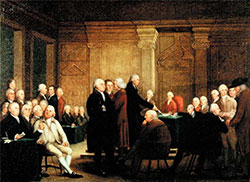 In 1774, delegates from the colonies met in Philadelphia. This was called the First Continental Congress. The delegates sent a statement to the British King explaining the colonists' views on the increasing number of taxes. In addition, they asked that the colonists be allowed to make their own laws. Meanwhile, the colonists and British troops fought over supplies of arms the colonists had stored at Concord, Massachusetts. This was the first blood shed in the Revolutionary War.
In 1774, delegates from the colonies met in Philadelphia. This was called the First Continental Congress. The delegates sent a statement to the British King explaining the colonists' views on the increasing number of taxes. In addition, they asked that the colonists be allowed to make their own laws. Meanwhile, the colonists and British troops fought over supplies of arms the colonists had stored at Concord, Massachusetts. This was the first blood shed in the Revolutionary War.
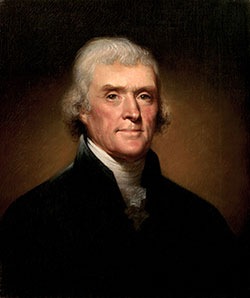 It
soon became clear that independence from England would be
necessary. Before the Continental Congress recessed, a Committee
of Five was appointed to draft a statement presenting
to the world the colonies' case for independence. The committee
consisted of two New England men, John
Adams of Massachusetts and Roger Sherman of Connecticut;
two men from the Middle Colonies, Benjamin
Franklin of Pennsylvania and Robert R. Livingston of
New York; and one southerner, Thomas
Jefferson of Virginia.
It
soon became clear that independence from England would be
necessary. Before the Continental Congress recessed, a Committee
of Five was appointed to draft a statement presenting
to the world the colonies' case for independence. The committee
consisted of two New England men, John
Adams of Massachusetts and Roger Sherman of Connecticut;
two men from the Middle Colonies, Benjamin
Franklin of Pennsylvania and Robert R. Livingston of
New York; and one southerner, Thomas
Jefferson of Virginia.
The members of the Committee of Five chose Thomas Jefferson to draft the document. Jefferson, while only thirty-three years old, had a wealth of experience in political service and writing. As a member of the Virginia House of Burgesses, he had written a political pamphlet entitled A Summary View of the Rights of British America and a draft of a proposed constitution for Virginia. These documents strongly influenced Thomas Jefferson in writing the first part of the Declaration of Independence. To learn more about this document, go to Historical Documents section of this web site.

Historical Documents
Declaration of Independence
 On
July 4, 1776 church bells rang out over Philadelphia announcing
the official adoption of the Declaration
of Independence. This important document proclaimed the
independence of the American colonies from Great Britain.
Although it is difficult to read, you can view the original
document that is housed at the National
Archives. In addition, you are invited to read a transcription of the complete text of the Declaration. If you want
to learn more about this important document, check out The
User's Guide to the Declaration of Independence. Check out the lyrics to the song Fireworks - SchoolHouse Rock's musical explanation of this important
document.
On
July 4, 1776 church bells rang out over Philadelphia announcing
the official adoption of the Declaration
of Independence. This important document proclaimed the
independence of the American colonies from Great Britain.
Although it is difficult to read, you can view the original
document that is housed at the National
Archives. In addition, you are invited to read a transcription of the complete text of the Declaration. If you want
to learn more about this important document, check out The
User's Guide to the Declaration of Independence. Check out the lyrics to the song Fireworks - SchoolHouse Rock's musical explanation of this important
document.
Constitution
After the 13 states won independence in the Revolutionary War (1775-1783), they faced the problems of peacetime government. The states had to enforce law and order, collect taxes, and regulate trade among themselves. Leading statesmen, such as George Washington and Alexander Hamilton, began to discuss the creation of a strong national government under a new constitution. Hamilton helped bring about a national convention that met in Philadelphia in 1787 to revise the Articles of Confederation. The articles granted each of the 13 original states independence in 1781, but they lacked the authority to make the states work together to solve national problems. Each state acted almost like an independent country. This is why a majority of the delegates at the convention decided not to revise the Articles of Confederation, but to write a new plan of government - the Constitution of the United States.
 The convention was supposed to open on May 14, 1787. But
few of the 55 delegates had arrived in Philadelphia by that
date. Finally, on May 25, the convention formally opened in Independence
Hall. Twelve states had responded to the call for the
convention. Rhode
Island refused to send delegates because it did not want
the national government to interfere with its affairs. The delegates,
or framers of the Constitution, included some of the most
experienced and patriotic men of the new republic. George
Washington served as the
president of the convention. Benjamin
Franklin, at the age of 81, represented Pennsylvania. James
Madison of Virginia was referred to as the "Father
of the Constitution" with his speeches, negotiations,
and attempts at compromise. After five weeks of debate, the
Constitutional Convention gave Governor
Morris the task of putting all of the convention's decisions
into a polished form.
The convention was supposed to open on May 14, 1787. But
few of the 55 delegates had arrived in Philadelphia by that
date. Finally, on May 25, the convention formally opened in Independence
Hall. Twelve states had responded to the call for the
convention. Rhode
Island refused to send delegates because it did not want
the national government to interfere with its affairs. The delegates,
or framers of the Constitution, included some of the most
experienced and patriotic men of the new republic. George
Washington served as the
president of the convention. Benjamin
Franklin, at the age of 81, represented Pennsylvania. James
Madison of Virginia was referred to as the "Father
of the Constitution" with his speeches, negotiations,
and attempts at compromise. After five weeks of debate, the
Constitutional Convention gave Governor
Morris the task of putting all of the convention's decisions
into a polished form.
Of the 55 delegates, 39 delegates signed the United States Constitution on September 17, 1787. After a farewell banquet, most delegates returned to their homes to organize support of this proposed charter. Before the Constitution could become the law of the land, nine states had to ratify or adopt it. Article VII of the Constitution detailed a four-stage ratification process. Less than three months after the Constitution was signed, Delaware became the first state to ratify it and New Hampshire was the ninth state, putting the Constitution into effect on June 21, 1788. It was not until May 29, 1790 that the last state, Rhode Island, finally accepted the Constitution.
The United States Constitution describes the structure of the government and the rights of the American people. It consists of a preamble, 7 articles, and 27 amendments. The Preamble describes the purpose of the document and of our government. The Articles establish how the government is structured and how the Constitution can be changed. The framers of the Constitution knew that issues would arise in the future that they could not anticipate, so they provided in the Constitution itself a mechanism to amend or change it. Today, there are 27 Amendment. The process of amending the Constitution was designed to be difficult, so that the nation would have to think carefully about any proposed changes before adopting them.
Have a little fun with the Constitution by completing a crossword puzzle and word search. Or, test your knowledge of the Constitution with this online quiz. If you like to sing, you can join the SchoolHouse Rock folks and sing the Preamble.
The Bill of Rights
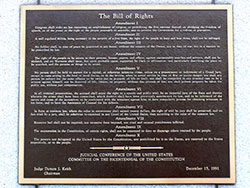 When the Constitution was adopted in 1788, many people were concerned that it did not protect certain freedoms. They thought that the Constitution should be changed or amended to protect these freedoms. On December 15, 1791, ten amendments were added to the Constitution. These amendments guarantee certain freedoms and rights, so they are known as the Bill of Rights. President Franklin D. Roosevelt proclaimed December 15 as Bill of Rights Day in 1941. Its purpose is to make Americans increasingly aware of their rights and responsibilities as citizens.
When the Constitution was adopted in 1788, many people were concerned that it did not protect certain freedoms. They thought that the Constitution should be changed or amended to protect these freedoms. On December 15, 1791, ten amendments were added to the Constitution. These amendments guarantee certain freedoms and rights, so they are known as the Bill of Rights. President Franklin D. Roosevelt proclaimed December 15 as Bill of Rights Day in 1941. Its purpose is to make Americans increasingly aware of their rights and responsibilities as citizens.
The Amendments contain the fundamental rights of every citizen. The First Amendment is the most important of the Bill of Rights. There are five different, yet very important parts to this amendment: Freedom of Speech, Religion, Press, Expression, and Freedom of Assembly. Today, courts and citizens must consider many challenging first amendment issues. To learn more about this amendment, go to the Citizens' Rights section of this web site.
The Second Amendment involves the question of who can bear arms. Many people, including legal scholars, disagree about its meaning. Some people argue that the amendment grants ordinary citizens the right to own guns. Other people claim the amendment only grants the states the right to organize some of their citizens into state-run militias.
The purpose of the Third Amendment was to require the military to receive home owners' consent before housing soldiers. Today this is not a concern, but at the time many citizens were resentful that the British military used their homes to house their soldiers. The Fourth Amendment protects citizens from unreasonable search and seizure by law enforcement. This amendment was included because many colonists were resentful of British officials who entered many homes and seized belongings. The Fifth Amendment is one of the more well-known in the Bill of Rights. It protects people against self-incrimination.
 The Sixth Amendment gives important rights to people who have been accused of a crime. One of these rights is to a trial by jury. The Seventh Amendment protects the rights of citizens in civil cases and guarantees the right to a trial by jury. The Eighth Amendment simply states that bail, fines, and punishments must not be unreasonable. These first 8 amendments contain the fundamental rights and freedoms of every citizen. The last two define the relationship among the people, the State governments, and the Federal Government. The Ninth Amendment forbids the government to limit freedoms and rights that are not listed in the Constitution. The Tenth Amendment limits the powers of the federal government to those that are granted to it in the Constitution.
The Sixth Amendment gives important rights to people who have been accused of a crime. One of these rights is to a trial by jury. The Seventh Amendment protects the rights of citizens in civil cases and guarantees the right to a trial by jury. The Eighth Amendment simply states that bail, fines, and punishments must not be unreasonable. These first 8 amendments contain the fundamental rights and freedoms of every citizen. The last two define the relationship among the people, the State governments, and the Federal Government. The Ninth Amendment forbids the government to limit freedoms and rights that are not listed in the Constitution. The Tenth Amendment limits the powers of the federal government to those that are granted to it in the Constitution.
Since the adoption of the Bill of Rights only 16 more amendments have been added to the Constitution. Although a number of these revised the federal government's structure and operations, most focused on expanding individual rights and freedoms.

Three Branches
It was important to the men who wrote the Constitution that they form a government that did not allow one person to have too much control. While under the rule of the British king they learned that this could be a bad system. Yet government under the Articles of Confederation taught them that there was a need for a strong centralized government. With this in mind, the framers wrote the Constitution to provide for three separate, but equally powerful, branches of government: the Legislative Branch (which writes the laws); the Executive Branch (which carries out the laws); and the Judicial Branch (which reviews the way laws are applied). The separation of powers allows for a system of checks and balances within the government. Each branch is given certain control over the other two, which balances the power and keeps the potential for abuse of power in check. Check out the lyrics to the SchoolHouse Rock song which describes our three branches of government.
Legislative Branch
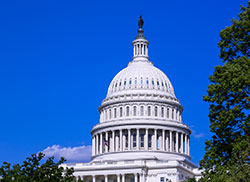 Article
I of the Constitution specifies that there shall be two
separate legislative bodies: a House
of Representatives and a Senate.
Together they are called the Congress.
The two bodies of Congress work together to write, debate,
and pass bills, which are then passed on to the President
for approval.
Article
I of the Constitution specifies that there shall be two
separate legislative bodies: a House
of Representatives and a Senate.
Together they are called the Congress.
The two bodies of Congress work together to write, debate,
and pass bills, which are then passed on to the President
for approval.
There are 100 senators and 435 representatives. Each of the 50 states elects 2 senators. The number of representatives is determined by each state's population. Each member represents an area of the state, known as a congressional district. The number of representatives is based on the number of districts in a state. Therefore, states with larger populations have more representation than states with smaller populations. (ex: California has 53 representatives and Utah has only 4 representatives.)
 Although Congress has numerous responsibilities and powers under the Constitution,
its chief function is to make laws. The legislative
process can be quite complicated. A proposed law, or
bill, must pass through a series of steps before it is voted
upon on the House and Senate floors. At any one of these steps,
a bill can be delayed, defeated, or amended (changed). Most
bills that are introduced do not survive this process and
do not become law. For more information on how laws are made
go to Ben's
Guide to U.S. Government or to The Legislative Process. SchoolHouse Rock also offers
a musical explanation of How
a Bill Becomes a Law.
Although Congress has numerous responsibilities and powers under the Constitution,
its chief function is to make laws. The legislative
process can be quite complicated. A proposed law, or
bill, must pass through a series of steps before it is voted
upon on the House and Senate floors. At any one of these steps,
a bill can be delayed, defeated, or amended (changed). Most
bills that are introduced do not survive this process and
do not become law. For more information on how laws are made
go to Ben's
Guide to U.S. Government or to The Legislative Process. SchoolHouse Rock also offers
a musical explanation of How
a Bill Becomes a Law.
Suppose you had fifteen minutes to describe the ten most important features of the U.S. Congress - could you do it? Don't worry, help is close by. Here is a great source on pending legislation.
Utah State Legislature
The Utah
State Legislature is similar in structure to the Federal
Legislature. There are 29 local elected Senators and 75 members in the House
of Representatives. Do you know who your state
legislators are? Use this interactive map to locate
your Utah
Senator and Utah
House of Representative.
Executive Branch
 The
executive branch of government makes sure that the laws of
the United States are obeyed. Article
II, section 1, of the Constitution vests the President
of the United States the head of the executive
branch. The United States has had 45 Presidents.
How many can you name? How many presidents have we had
in your life time? No women have been elected to the
Oval Office, yet women make up half the population of the
U.S. Do you think that a woman will be elected president in
the next decade? In the next twenty years? Ever? Why do you
think a woman has never been elected to the presidency?
The
executive branch of government makes sure that the laws of
the United States are obeyed. Article
II, section 1, of the Constitution vests the President
of the United States the head of the executive
branch. The United States has had 45 Presidents.
How many can you name? How many presidents have we had
in your life time? No women have been elected to the
Oval Office, yet women make up half the population of the
U.S. Do you think that a woman will be elected president in
the next decade? In the next twenty years? Ever? Why do you
think a woman has never been elected to the presidency?
The President
To learn more about U.S. Presidency, explore these resources:
- The American Presidential Biographies: A very comprehensive guide to the presidents of the United States.
- Check out this index of Presidential Speeches.
- Have you seen the Portraits of the Presidents and First Ladies?
- George Washington was not the first president. Find out who was.
Now you should be ready to complete these activities:
- Test your presidential knowledge by taking one of this online quiz: U.S. Presidents Facts Quiz.
- Play Who is That? You will be shown a portrait of a president with a clue.
- How well do you really know our presidents? Match the presidents with their hobbies.
Vice President
The Vice President of the United States is second in command. This person must be ready to become president or acting president at a moment's notice if the president dies, resigns, is removed from office, or becomes unable to perform the duties of office. Only nine of our nation's 45 vice president have had to do this: John Tyler, Millard Fillmore, Andrew Johnson, Chester A. Arthur, Theodore Roosevelt, Calvin Coolidge, Harry S. Truman, Lyndon B. Johnson, and Gerald R. Ford.
The Constitution of the United States defines only one official duty for the vice president. He is the president of the U.S. Senate. The president, however, can choose to delegate additional responsibilities to this person and since 1933, the vice presidents have attended meetings of the president's Cabinet. At this point, only six vice presidents have been successfully elected as president: John Adams, Thomas Jefferson, Martin Van Buren, Richard Nixon, George Bush and Joe Biden.
You may want to read the biographies of Vice Presidents and then take the Vice Presidents Trivia Quiz.
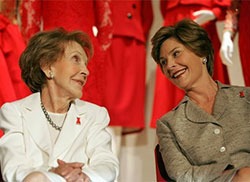 First Lady
First Lady
The
wife of a president is called the First
Lady. Read about some of our most recent first ladies, Jill Biden, Melania Trump, Michelle Obama, Laura
Bush, Hillary Rodham Clinton, Barbara
Bush, Nancy
Reagan, Rosalyn
Carter, Betty
Ford, Patricia Nixon, Lady
Bird Johnson and Jacqueline
Kennedy, and learn how they have influenced their husband's
administration. Many of these women were activists for
issues of their times. Discover which first lady was
a champion of women's rights, which started a "Just Say
No to Drugs" campaign, which supported mental health
programs and which focused on adult literacy.
The Executive branch is very large so the President gets help from the Vice President, department heads (Cabinet members), and heads of independent agencies.
If you have questions for the President, Vice President, or First Lady send them an email message:
The Cabinet
 The
Cabinet is composed of the heads of the 14 executive departments:
The
Cabinet is composed of the heads of the 14 executive departments:
- Department of Agriculture
- Department of Commerce
- Department of Defense
- Department of Education
- Department of Energy
- Department of Health and Human Services
- Department of Housing and Urban Development
- Department of the Interior
- Department of Justice
- Department of Labor
- Department of State
- Department of Transportation
- Department of the Treasury
- Department of Veterans Affairs
Government Agencies
There are several administrative divisions of the government whose job it is to enforce and administer laws and regulations. Because provisions for these agencies were not outlined in the Constitution, they are considered independent extensions of the U.S. government. Here is a list of some of the major agencies.
- Central Intelligence Agency
- U.S. Commission on Civil Rights
- Consumer Product Safety Commission
- Environmental Protection Agency
- Federal Election Commission
- Federal Emergency Management Agency
- Federal Trade Commission
- Global Learning and Observations to Benefit the Environment (G.L.O.B.E.)
- National Aeronautics and Space Administration
- National Foundation on the Arts and the Humanities
- National Science Foundation
- National Transportation Safety Board
- U.S. Patent and Trademark Office
- Peace Corps
- U.S. Postal Service
- Small Business Administration
- Social Security Administration
The Executive Branch at the State level is a bit different than the Federal Level. Instead of having a president, states have Governors. Take a minute to read about Utah's past governors. Other major offices include Lt. Governor, Attorney General, State Treasurer and State Auditor.
Judicial Branch
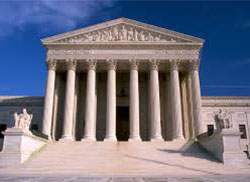 The
role of the judicial
branch is to interpret the nation's laws. It consists
of two separate levels of courts: state
courts and federal
courts. The type of court that a case is tried in depends
on the law that was allegedly violated. Most of the laws that
govern our day-to-day living are state
laws. Violations of federal
law include offenses involving federal government employees,
crimes committed across state lines (for example, kidnapping
or evading arrest), and fraud involving the national government
(such as income tax or postal fraud).
The
role of the judicial
branch is to interpret the nation's laws. It consists
of two separate levels of courts: state
courts and federal
courts. The type of court that a case is tried in depends
on the law that was allegedly violated. Most of the laws that
govern our day-to-day living are state
laws. Violations of federal
law include offenses involving federal government employees,
crimes committed across state lines (for example, kidnapping
or evading arrest), and fraud involving the national government
(such as income tax or postal fraud).
Utah Courts
The Federal and the Utah State judicial systems include both trial courts and appellate courts. Trail Courts conduct the first hearing of a case, and appellate courts review a trial court's decision at the request of the losing party. The Utah State Court System is comprised of two appellate courts - the Supreme Court and Court of Appeals. Utah trial courts include the District Court, Juvenile Courts, and Justice Courts. These courts are located in each of the state's eight judicial districts. If you don't know which district you live in, use the Judicial Locator Map. These courts handle most criminal matters and most legal business concerning marital disputes, probate of estates, land deals, commercial contracts, and other day-to-day matters.
Federal Courts
 The federal courts, in contrast, have power to decide only those cases over which the Constitution gives them authority. These courts are located principally in the larger cities. If
the federal court system is viewed as a pyramid, at the top is the Supreme Court of the United States, the highest court. On the next level are the 13 United States Courts of Appeals and the U.S. Court of Appeals for the Armed Forces.
The federal courts, in contrast, have power to decide only those cases over which the Constitution gives them authority. These courts are located principally in the larger cities. If
the federal court system is viewed as a pyramid, at the top is the Supreme Court of the United States, the highest court. On the next level are the 13 United States Courts of Appeals and the U.S. Court of Appeals for the Armed Forces.
Utah is in the Tenth Circuit along with the states of Colorado, Kansas, New Mexico, Oklahoma, and Wyoming, plus those portions of the Yellowstone National Park extending into Montana and Idaho. On the following level are the 94 U.S. district courts and the specialized courts, such as the Tax Court, the Court of Federal Claims, the Court of Veterans Appeals, and the Court of International Trade. The U.S. District Court for Utah is located in Salt Lake City.
Federal cases are usually begun at the district court level. If a party is not satisfied with the decision, they may have the decision reviewed in one of the courts of appeals. If dissatisfied with the decision of a court of appeals, the party may seek additional review in the Supreme Court of the United States; however, the Supreme Court primarily reviews only cases that involve a matter of great national importance and only accepts a small number of cases each term. Read some of the current and past Supreme Court Decisions. Have some fun and take a Virtual Tour of the Supreme Court Building. (Note: You need the QuickTime 4.1 plugin installed.)
Jury Service
The Sixth
Amendment of the United States Constitution guarantees
a speedy, fair trial before a jury of one's peers. A jury
consists of 12 people who are selected to hear the evidence
in a trial. After the jurors hear the evidence presented during
the trial, they must try to decide if the defendant is guilty
or not guilty. Read Utah's Guide
to Jury Service.
Judges / Justices
Courts are presided over by judicial officers. In the courts of appeals, district courts, and other courts, most of the judicial officers are called judges. Where a jury is used, the jury decides questions of fact and the judge decides all questions of law. When all the evidence has been heard, and the lawyers for both sides have addressed the jury, the judge charges the jury, telling it what rules of law apply to the case. A jury is not always used. In some cases, the law requires a judge to decide on the facts. Or perhaps the parties do not want a jury to decide the case. In these cases, the judge decides based on fact and law.
Utah's highest court is the state supreme court. This court has five justices, elected to 10-year terms. The justice with the shortest remaining period in office serves as chief justice. Each of Utah's 8 districts has one or more district court judges, depending on population.
In the United States Supreme Court, the judicial officers are called justices consisting of a chief justice and associate justices. When a vacancy opens, the President nominates a new justice who is then confirmed or rejected by the Senate.

Our Capital Cities
Washington, D.C.
 Washington
D.C. is the capital of the United States and it serves
as the headquarters
of the federal government. The President
of the United States, the members of Congress,
the Supreme
Court justices, and federal government
employees work in the Washington area.
Washington
D.C. is the capital of the United States and it serves
as the headquarters
of the federal government. The President
of the United States, the members of Congress,
the Supreme
Court justices, and federal government
employees work in the Washington area.
Washington D.C. lies in the southeastern United States, between Maryland and Virginia. It is the only American city or town that is not part of a state. Washington covers the entire area of the District of Columbia, a section of land that is under the jurisdiction of the federal government. Most of Washington's government buildings, famous monuments and museums, and other tourist attractions are located in the west-central part of the city. This area extends from Capitol Hill, which rises near the center of the city, west to the Potomac River.
Capitol Hill
Capitol
Hill is near the center of Washington. Several huge government
buildings stand on the hill. They include the United
States Capitol, congressional office buildings, the Library
of Congress, the Supreme
Court Building, and the conservatory of the United
States Botanic Garden. Go to The
United States Capitol Building section
of this web site to learn more about that federal building.
 Library
of Congress is probably the world's largest library. Its
huge collection of about 100 million items includes books,
manuscripts, films, and recordings. The library serves the
reference needs of Congress and the research needs of scholars.
The public may also use its materials and tour the buildings.
Items of special interest include most of Mathew
Brady's Civil War photographs, Scrolls
from the Dead Sea, and two copies of Abraham Lincoln's Gettysburg
Address that were handwritten by Lincoln.
Library
of Congress is probably the world's largest library. Its
huge collection of about 100 million items includes books,
manuscripts, films, and recordings. The library serves the
reference needs of Congress and the research needs of scholars.
The public may also use its materials and tour the buildings.
Items of special interest include most of Mathew
Brady's Civil War photographs, Scrolls
from the Dead Sea, and two copies of Abraham Lincoln's Gettysburg
Address that were handwritten by Lincoln.
The National Mall
The National
Mall, or simply the Mall, is a long, narrow park like
area that stretches westward from Capitol Hill. This is the
location of some of the city's leading tourist attractions
and the site for many festivals, demonstrations, and celebrations.
Several outstanding museums that are part of the Smithsonian
Institution are located along the Mall west of Capitol
Hill. The Smithsonian Institution operates cultural, educational,
and scientific facilities throughout Washington, D.C. The
facilities include several
museums on the Mall that house of more than 130
million items.
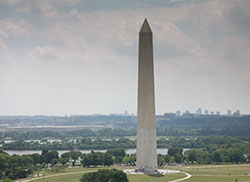 Farther
west are the Washington Monument and Lincoln Memorial. The Washington
Monument is a slender, white marble pillar dedicated to
the memory of George
Washington. It is the tallest structure in Washington,
D.C. rising 555 feet 51/8 inches. An elevator inside carries
visitors to the top. Lincoln
Memorial is a white marble monument that honors Abraham
Lincoln. On the outside, 36 columns (one for each state
that existed when Lincoln died) support the roof. Inside is
a majestic marble statue of Lincoln seated in a chair.
Farther
west are the Washington Monument and Lincoln Memorial. The Washington
Monument is a slender, white marble pillar dedicated to
the memory of George
Washington. It is the tallest structure in Washington,
D.C. rising 555 feet 51/8 inches. An elevator inside carries
visitors to the top. Lincoln
Memorial is a white marble monument that honors Abraham
Lincoln. On the outside, 36 columns (one for each state
that existed when Lincoln died) support the roof. Inside is
a majestic marble statue of Lincoln seated in a chair.
The Vietnam Veterans Memorial is located east of the Lincoln Memorial. This is a dedication to those who served in the Vietnam War; it includes two black granite walls that meet at an angle. The names of all Americans who died in the war, or who remained classified as missing in action when the walls were built, are inscribed on the two black granite walls. The memorial also includes large bronze sculptures of servicemen and servicewomen.
The Korean War Veterans Memorial is also east of the Lincoln Memorial. It includes 19 large stainless steel sculptures of American Korean War servicemen. It includes a black granite wall that reflects the sculptures. The wall has engraved images of about 2,500 nurses, mechanics, and other military people who served in Korea.
The Jefferson Memorial and the Roosevelt Memorial lie south of the Washington Monument. The Thomas Jefferson Memorial is a shrine to the third President of the United States and author of the Declaration of Independence. The memorial is a white marble circular building with a porch supported by 12 columns. A 19-foot statue of Jefferson by the American sculptor Rudulph Evans stands inside the memorial.
The Franklin Delano Roosevelt (FDR) Memorial honors Franklin D. Roosevelt, the 32nd president of the United States. The FDR Memorial covers about 71/2 acres and includes four partially walled-off areas called rooms. Each room represents one of Roosevelt's terms.
North of the Mall
Many government buildings are located in the area north of the Mall. Most of them stand along or near Pennsylvania Avenue. This broad, tree-lined street runs  northwestward from Capitol Hill. It connects the Capitol and the White House, and serves as Washington's main parade route. The White House is the most important government building in the area. Go to the White House section of this web site to learn more about this building. Most of the other buildings house offices of the executive branch of the government.
northwestward from Capitol Hill. It connects the Capitol and the White House, and serves as Washington's main parade route. The White House is the most important government building in the area. Go to the White House section of this web site to learn more about this building. Most of the other buildings house offices of the executive branch of the government.
Many tourists like to visit the National Archives and the headquarters of the Federal Bureau of Investigation. The National Archives stores government documents. It displays three of the most important documents for public viewing. These are the original copies of the United States Constitution, the Bill of Rights, and the Declaration of Independence. At FBI headquarters, bureau agents conduct tours that feature highlights of the agency's history and show how the FBI works today. The tours end with a demonstration of agents taking target practice.
Ford's Theatre, the playhouse where Abraham Lincoln was shot, stands about 1 1/2 blocks north of Pennsylvania Avenue, between the White House and Capitol. The theater houses a collection of items related to Lincoln's life and death. Petersen House, the house where Lincoln died, is across the street from the theater.
South of the Mall
Originally,
almost all the executive branch buildings were located near
the White House. But the executive branch has grown tremendously
and has spread out to other parts of Washington. Several government
buildings now stand south of the Mall. They include the buildings
of six executive departments. These departments are Agriculture, Education, Energy, Health and
Human Services, Housing
and Urban Development, and Transportation.
In addition, the United
States Postal Service, is south of the Mall.
The Bureau of Engraving and Printing is a major tourist attraction south of the Mall. There, government workers engrave and print the country's paper money. Many visitors flock to the bureau to see these fascinating processes. The United States Holocaust Memorial Museum stands next to the bureau's buildings. The Holocaust Museum's exhibits honor the millions of Jews and other people murdered by the Nazis during World War II.
Other Points of Interest
The Washington area has dozens of interesting sights in addition to those already described.
 John
F. Kennedy Center for the Performing Arts borders the Potomac
River northwest of the Lincoln Memorial. Drama groups,
ballet and opera companies, and orchestras from all parts
of the world perform in this modern building. The Kennedy
Center also serves as the permanent residence of the American
Film Institute, the Washington
Opera, and the National
Symphony Orchestra.
John
F. Kennedy Center for the Performing Arts borders the Potomac
River northwest of the Lincoln Memorial. Drama groups,
ballet and opera companies, and orchestras from all parts
of the world perform in this modern building. The Kennedy
Center also serves as the permanent residence of the American
Film Institute, the Washington
Opera, and the National
Symphony Orchestra.
National Zoo is about 2 miles north of the White House. The zoo contains more than 4,000 animals. Pentagon Building, the headquarters of the Department of Defense, is known as the world's largest office building. It covers 29 acres in Arlington, Virginia, across the Potomac from Washington. Arlington National Cemetery, which lies northwest of the Pentagon in Arlington, contains the graves of thousands of men and women who served in the United States armed forces. It includes the Tomb of the Unknowns, where four unidentified servicemen who died in action are buried. The cemetery also includes the gravesites of President John F. Kennedy and his wife, Jacqueline; and of President William Howard Taft.
Marine Corps War Memorial, north of Arlington Cemetery, ranks among Washington's most famous monuments. Often called the Iwo Jima Statue, this dramatic bronze sculpture shows five marines and a Navy medical corpsman raising the American flag on the island of Iwo Jima during World War II. Mount Vernon was the private estate of George Washington. It is located in Fairfax County, Virginia, about 15 miles south of the city. The first President's home, many of his belongings, and his grave are there.
The United States Capitol Building
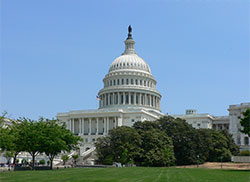 The
Capitol of the United States is located on Capitol
Hill in Washington, D.C. This is the building where Congress
meets. Built in the 19th-century neoclassical style, the building
consists of two wings that extend north and south of a central
section. A huge white dome rests on the central section of the building. On top of the
dome stands the Statue
of Freedom - a 191/2 feet high figure of a woman wearing
a headdress of eagle feathers and holding a sword and shield.
The
Capitol of the United States is located on Capitol
Hill in Washington, D.C. This is the building where Congress
meets. Built in the 19th-century neoclassical style, the building
consists of two wings that extend north and south of a central
section. A huge white dome rests on the central section of the building. On top of the
dome stands the Statue
of Freedom - a 191/2 feet high figure of a woman wearing
a headdress of eagle feathers and holding a sword and shield.
The Capitol has 540 rooms, including offices and reception rooms. Many rooms hold mementos of U.S. history as well as paintings and sculptures by some of the country's greatest artists. Construction of the original building took thirty-four years [1793-1827] and was directed by six presidents and six architects.
The idea of a permanent capital for the government of the United States was first raised by Congress in 1783. In 1791, President Washington selected the area that is now the District of Columbia from the land ceded by the state of Maryland. In 1792, the government held a contest for a Capitol design. A doctor and amateur architect named William Thornton, submitted the winning entry.
President George Washington laid the building's cornerstone in 1793, but construction proceeded slowly under a succession of architects, including Stephen Hallet (1793), George Hadfield (1795-98) and James Hoban (1798-1802), the architect who completed the Senate wing in 1800. This allowed Congress to move from Philadelphia into the north wing of the Capitol. The Supreme Court, the Library of Congress, and the courts of the District of Columbia were able to occupy the Capitol in late 1800.
 In
1803, Congress allocated funds to resume construction. Benjamin
Henry Latrobe, the first professional architect and engineer
to work in America, was hired to oversee the renewed construction
effort. Latrobe proposed
design changes to Thornton's plan. By 1807 enough
construction was completed to allow the House of Representatives
to move into the south wing. This wing was completed
in 1811, but further projects were difficult to complete because
funding was being spent on a second war with Great Britain,
known as The
War of 1812. On August 24, 1814, British troops set fire
to the building. Latrobe was rehired in 1815 to restore
the Capitol, however not much progress was made and he resigned
in 1817.
In
1803, Congress allocated funds to resume construction. Benjamin
Henry Latrobe, the first professional architect and engineer
to work in America, was hired to oversee the renewed construction
effort. Latrobe proposed
design changes to Thornton's plan. By 1807 enough
construction was completed to allow the House of Representatives
to move into the south wing. This wing was completed
in 1811, but further projects were difficult to complete because
funding was being spent on a second war with Great Britain,
known as The
War of 1812. On August 24, 1814, British troops set fire
to the building. Latrobe was rehired in 1815 to restore
the Capitol, however not much progress was made and he resigned
in 1817.
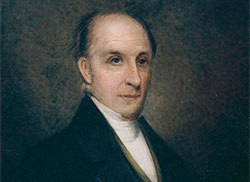 1818, Charles
Bulfinch, a Boston architect, replaced Latrobe.
Over an eleven year period he worked on restoring the north
and south wings and the center section. In 1827 the Capitol
Building was completed. By 1851, however, construction
began again because it was too small for the increasing numbers
of senators and representatives from newly admitted states. Thomas
U. Walter, a Philadelphia architect, was chosen to expand
the capitol. By 1856 the old dome was replaced with
new fireproof, cast-iron
dome and in 1863 the Statue
of Freedom was placed on top of the dome. The Capitol
extensions were completed in 1868.
1818, Charles
Bulfinch, a Boston architect, replaced Latrobe.
Over an eleven year period he worked on restoring the north
and south wings and the center section. In 1827 the Capitol
Building was completed. By 1851, however, construction
began again because it was too small for the increasing numbers
of senators and representatives from newly admitted states. Thomas
U. Walter, a Philadelphia architect, was chosen to expand
the capitol. By 1856 the old dome was replaced with
new fireproof, cast-iron
dome and in 1863 the Statue
of Freedom was placed on top of the dome. The Capitol
extensions were completed in 1868.
Additional restorations and renovations have been made to the Capitol over the years. If you are interested in learning more about the history of this important building, two excellent web sites have been created on this topic:
- The United States Capitol - developed by the Architect of the Capitol
- Temple of Liberty: Building the Capitol for a New Nation - developed by the Library of Congress
Images from The United States Capitol web site: https://www.aoc.gov/architecture
The White House
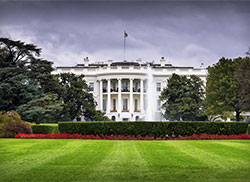 The White
House is the official residence of the President United
States and his family. Located at 1600 Pennsylvania
Avenue in Washington, D.C, it is one of the most popular tourist
attractions in the country receiving approximately 6,000 visitors
a day. Not all presidents, however, got to live in the White
House. Our first President, George
Washington, picked the site on the Potomac River in the
late 1700's. A contest was held to select a designer
for the house and James
Hoban won the contest. Washington was president during
the construction of the White House, but he never lived there.
The White
House is the official residence of the President United
States and his family. Located at 1600 Pennsylvania
Avenue in Washington, D.C, it is one of the most popular tourist
attractions in the country receiving approximately 6,000 visitors
a day. Not all presidents, however, got to live in the White
House. Our first President, George
Washington, picked the site on the Potomac River in the
late 1700's. A contest was held to select a designer
for the house and James
Hoban won the contest. Washington was president during
the construction of the White House, but he never lived there.
John Adams, the second president, was the first to live in the White House. During the War of 1812 British soldiers set fire to the White House. James Madison was the president at the time and his wife, Dolly Madison, stayed behind until the very last minute to collect important papers. Take a moment to read the letter Dolly wrote to her sister the day before the burning.
Learn about the history of this famous building while taking
a virtual
tour, and then try to answer these questions: 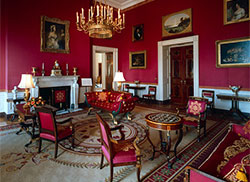
- Which room did the Theodore Roosevelt Administration host a wrestling match in?
- The White House has a Blue Room, Green Room, and a Red Room. Did you discover which room is sometimes called the Gold Room?
- What was the room that is now the Library used for prior to 1902?
- During World War II President Franklin D. Roosevelt used the Map Room to follow the course of the war. What is the room used for now?
- Does the China Room actually have china in it?
- Which room does the president sign bills and Executive Orders and meet with staff, visitors, and guests?
Activities:
- Explore the interactive map of the President's Neighborhood.
Learn More:
Salt Lake City
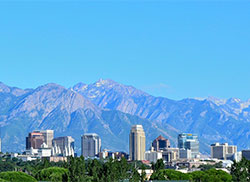 Salt Lake City is the capital city of Utah. It lies in a
mountain valley with the Wasatch
Mountains to the east and north and the Oquirrh
Mountains (pronounced “oaker”) border the western
edge of the valley. The city is named after the Great
Salt Lake which is nearby. This lake is unusual
because it is saltier than the oceans. The reason for this
is because
its waters do not drain away, instead they evaporate, leaving
salt behind. If you go out to see the lake, be sure to visit Saltair,
a former resort and amusement park. Now it is used as
a concert venue.
Salt Lake City is the capital city of Utah. It lies in a
mountain valley with the Wasatch
Mountains to the east and north and the Oquirrh
Mountains (pronounced “oaker”) border the western
edge of the valley. The city is named after the Great
Salt Lake which is nearby. This lake is unusual
because it is saltier than the oceans. The reason for this
is because
its waters do not drain away, instead they evaporate, leaving
salt behind. If you go out to see the lake, be sure to visit Saltair,
a former resort and amusement park. Now it is used as
a concert venue.
One of Salt Lake City's most popular places to visit is Temple
Square - the center of the Church of Jesus Christ of Latter-day
Saints. Here one can find the The Salt Lake Temple and the Tabernacle. The The Tabernacle Choir is famous for its choir and large organ. Temple Square is located in the very heart
of downtown Salt Lake City. Nearby, you will also find
the City
and County building and the Scott
Matheson Courthouse. The City and 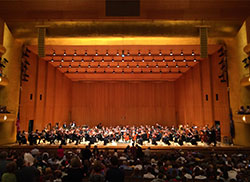 County building is where city officials conduct government
business.
County building is where city officials conduct government
business.
Also in downtown Salt Lake City is the Clark Planetarium. The planetarium has a space museum with lots of exhibits and it presents daily star shows and laser music concerts. If you are looking for a different type of music, visit the Utah Symphony in Maurice Abravanel Hall, acclaimed as one of the world's great concert halls. The Tracy Aviary is another great place to visit. It is home to over 1000 birds, including peacocks, eagles and owls. Salt Lake's Hogle Zoo is also home to some birds and other animals.
Across the street from the zoo is the This Is The Place Heritage Park where you can see the West as it was in the early settlement of Utah. This park is also where the famous This is the Place monument is located. Legend has it that this is where Brigham Young, leader of the Mormon pioneers, declared "This is the place!"
Near these historical markers is the University of Utah campus which was one of the venues for the 2002 Winter Games. The U of U is also where you can find the Natural History Museum of Utah. This museum contains collections from The University of Utah departments of anthropology, biology and geology.
Utah State Capitol Building
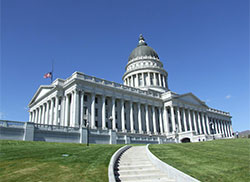 The Utah State Capitol stands in the northern part of downtown Salt Lake City. It was completed in 1914 and patterned after the nation's capitol. The building contains the various architectural symbolism of American democracy: the dome, the balanced wings for the divisions of government, and the classic Greek and Roman decorative elements. The columns, along with the rest of the exterior, were constructed from granite taken from Little Cottonwood Canyon in Salt Lake County.
The Utah State Capitol stands in the northern part of downtown Salt Lake City. It was completed in 1914 and patterned after the nation's capitol. The building contains the various architectural symbolism of American democracy: the dome, the balanced wings for the divisions of government, and the classic Greek and Roman decorative elements. The columns, along with the rest of the exterior, were constructed from granite taken from Little Cottonwood Canyon in Salt Lake County.
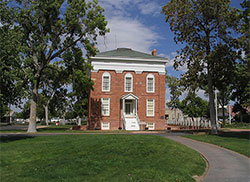 It is much different than Utah's first Capitol Building located in Fillmore, Utah. Prior to statehood, the first legislative assembly of the territory chose Fillmore in Millard County for their capitol building because it was nearly in the geographical center of this large territory. In 1855 one section of the building was completed, and the legislature met there for 3 sessions. However, most legislators found that Fillmore was too far from Salt Lake, the economic center of the territory, and they voted to move the capitol building to its present location. Today, the building in Fillmore is a museum of pioneer artifacts run by the State of Utah Division of Parks and Recreation.
It is much different than Utah's first Capitol Building located in Fillmore, Utah. Prior to statehood, the first legislative assembly of the territory chose Fillmore in Millard County for their capitol building because it was nearly in the geographical center of this large territory. In 1855 one section of the building was completed, and the legislature met there for 3 sessions. However, most legislators found that Fillmore was too far from Salt Lake, the economic center of the territory, and they voted to move the capitol building to its present location. Today, the building in Fillmore is a museum of pioneer artifacts run by the State of Utah Division of Parks and Recreation.


 UTAH EDUCATION NETWORK
UTAH EDUCATION NETWORK

 Justin
Justin Braxton
Braxton Dani
Dani Kayla
Kayla Katie
Katie Lora
Lora Rob
Rob Val
Val

